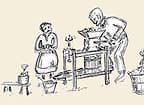|
'Hello Girls' and Party Lines
Telephone History in the Vicinity of Honeoye Falls, NY
by
Paul S. Worboys
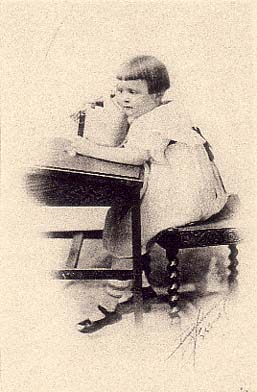
"
Number please."
"
Twait, twem!" came the adolescent utterance.
" I am sorry/' the
feminine voice replied, enunciating
every syllable, " would you repeat
that please?"
" Ah, oh,... 2,
8, 2, M, ma'am."
" Thank y-e-e-w. I will connect you."
Lacking a resemblance to the technology of our newest millennium, this
exchange between a telephone operator and a youngster was a normal slice
of life in America
for many decades. It was an institution buried, for better or worse, by the present
helter-skelter world of instant communication.
Television depicts cell phone ads from Oz, singing a merry tune as they project
us face-to-face, Boston to Bangkok, in a fiberoptic soup of good intentions.
But who among us appreciates the lineage that brought us Alexander Graham Bell,
Gary Winnick and all between?
In tracing our telephonic roots from that little thing that keeps following
loose change into the recesses of the old recliner, there is pride in knowing
from whence we came. These are our own local forebears... Global Crossing,
Frontier Corporation, Rochester Telephone, Home Telephone, that staid little
giant The Mendon Center Telephone Company and, of course, Bell.
Not to be forgotten are the two young whippersnappers who, in the 1880's, convinced
a few farmfolk that their "make & break" system (strung out on
rail fences, tree limbs and such) was more than Ma Bell could handle.
In 1900, a mere century ago, the Industrial Age was in full flower. Rural isolation,
however, was so palatable that a postal card informed folks in town that all
was o.k.. but for a touch of lumbago. Along with electricity and all its inherent
do-dads to come, the automobile was beginning to make an appearance throughout
the land. Thanks to changing folkways, the symbiont relationship of farmer
and crossroads merchant commenced its inexorable descent into oblivion.
Today, the Wal-Mart, email and "pay-at-the pump" existence rushes
forth at lightning speed... with the cellular progeny of Great-Great-Great
Grandpa Bell ever at the ready. While the weaving of this little story about
telephones will ultimately wend us back to our reality of 2003, consider a
time when every convenience we take for granted was primitive, if even conceived.
"Our Telephone Has Arrived"
Numerous events transpired in the world of "telephony" once it
fell under the patent right of Bell's #174,465 in 1876. Described by one scribe
as "this great contrivance," the transmission of intelligible sentences
beyond the range of the human voice applied a technological bear hug to the
human race. Its increasing squeeze continues to this day.
Prior to Bell's success, there was a lot of madcap scrambling to be the first
to get rich from voice transmission. Even small-town geniuses were doing what
they could for the cause, for even the hardy people of the 19th century were
ever-mindful of the Utopian term, convenience .
In Honeoye Falls, the successful mercantile and banking partnership of Timothy
Holden and his son Alexander, inspired the younger man to set up a rudimentary
communication system between his home and the Holden Bank. This contraption
pre-dated Bell's device by a couple of years, though no one was about to attempt
a patent on it. A recipe of piano wire, sleigh bells and a wooden disc fashioned
into a mouthpiece diaphram, was set in motion by a whack that vibrated clear
to the opposing station. A duplicate system reversed the pattern—and enterprising
Alex Holden had a leg up on the competition.
The good banker continued his primitive system until 1883, when the Bell
Company of Buffalo arrived and set up a phone exchange at (George) Dutton & (Alba)
Allen's drug store (in the present video store block). Since Bell's patent
carried until 1893, any authentic telephone equipment was only acquired through
that company, so the wealthy Holden bought the gear and (a half-century later)
his crude system found a home at the Rochester Historical Society Museum.
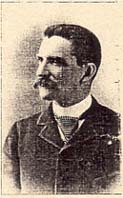
George Roland Dutton
Surprisingly, Mendon township already had a telephone line traversing its jurisdication
upon Bell's connection to Honeoye Falls. The Rochester Water Works conduit
#1, running from Hemlock Lake via Mendon's southwest quadrant to the reservoir
at Cobbs Hill, was shadowed by a telegraph line when built in 1876. However,
all the hubbub over Bell's patent quickly led to a 'phone line strung on the
same poles, allowing voice communication between managers at each end. Additionally,
the folks around Rush Reservoir, Hemlock, Richmond Mills, Honeoye Falls and
the Monroe County Alms House had stations to send or receive messages.
Sam Morse's telegraphic code was junked by 1879 and, for a time, the longest
long-distance line in America was arguably the 28-mile system of the Rochester
Water Works. We might assume such a convenience would result in abusing the
system that was designed for the benefit of the waterworks boys. On the contrary,
people back then were far from the frantic state 21st Century dwellers seem
to be in when it comes to connecting with others of our species. That same
year, Bell published its first directory for the City of Rochester, with
70 names, no numbers and no addresses.
While most Honeoye Falls citizens acquired a taste for phones by trouping
down to Button & Allen's and paying a dime or so to contact exchanges
in other towns, a few prominent folk joined the Holdens and paid good money
for private lines. For instance, an 1884 Honeoye Falls Times ad
by Dr. C.F. Otis ["Homeopathic Physician and Surgeon, 13 North Main
Street"] noted that, "calls by telephone at night will meet prompt
attention." Originally, Doc Otis was alerted by an electric bell, activated
from Dutton's—to which he had to rush down the street to accept the call,
often in his nightshirt. But brisk business by after-hours hypochondriacs
led the two parties to set up a phone strictly for the doctor's use.
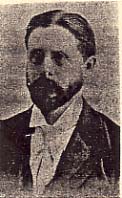
Chas. F. Otis, M.D.
Throughout the early 1880's, towns welcomed telephone construction crews stringing
wire and (early on at least) replacing their beautiful shade trees with gangly
poles of dubious posture. Bell's wire tentacles streamed throughout Western
New York, claiming great gobs of territory as a hedge against the day when
Patent #174,465 would expire. Lines went up from Palmyra to Victor, Naples
to Canandaigua and on through the Bloomfields. The citizens of Millers Corners,
with a railroad AND telephones, began to fancy a new tag for their progressive
little burg. It took some time to make the change, but everyone now living
has only known this fair realm as Ionia.
By mid-1888, after rate increases and shoddy service led to an eighteen month
strike by Bell subscribers, George Roland Dutton was still the sole telephone
businessman in Honeoye Falls. The druggist advertised that Bell had installed
a long distance connection
to any of Rochester 's 700 phones and over 3,000 regionwide, "Call at
Dutton's for rates."
All was not peachy with the Dutton operation, especially with a billiard hall
overhead. Anchoring the east end of the Wilcox-Dann Block (video store), the
thwack and cackle from above was more than distracting for the Bell operator
situated below. However, in 1892, as the banker Holden completed a move into
a newly-constructed building situated at the end of the store row, Rollie Dutton
saw his chance and filled the vacancy three doors away. To assure quietude
overhead, the modest community library was encouraged to continue its lease
and thwart the forces of youth and intemperance.
That year a long-distance call from New York City to some boomtown called "Chicago," set
the new mark for propelling the human voice. By this time, the old Rochester
Water Works record of 28 miles was yesterday's news.
"Hello Mendon Center!"
Momentous as that NY-Chicago call was, the year to follow, 1893, was an earthquake
to the telephone world. When Alec Bell's patent expired, American Bell Telephone
hoped that saturating the major population markets with Bell products and
services would temper the ardor of independent phone companies. But the American
hinterland was fertile ground for energetic people schooled in the nuances
of voice transmission. When the patents expired the floodgates burst open:
"As if in a textbook demonstration of the virtues of free enterprise,
independent
companies sprang up to serve the rural areas that
American Bell had neglected.
"By 1900, more than a thousand independent
local exchanges had
been established in Iowa alone, and more than 6000
in the whole country.
In addition,
thousands of telephones were supported by cooperative
do-it-yourself
systems in areas served neither by the Bell Company nor
by the independents."—American Heritage, July, 1985.
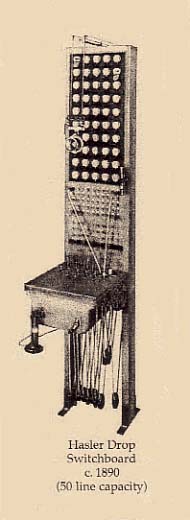
As the turn-of-the century approached, Bell hung dearly to its established
lines, including Dutton's in Honeoye Falls. But this village was a hotbed of
scientific curiosity, especially in the households of young John Lapp on Monroe
Street and Fred Locke, opposite the New York Central station on Railroad Avenue
(Norton Street today). They were prodigies—with Lapp keenest on telephone
technology and Locke into insulators (those glass or porcelain connectors for
telegraph, telephone and eventually power lines). For the time being, Locke
supported Lapp in his quest to be a telephone tycoon, but
later, the insulator industry beckoned.
Having earlier perfected the "make and break" telephone with one
John Dann, Lapp prepared for an independent telephone business. He was well
aware that farm folk in towns all around were stirring with desire to connect
by phone with one another and the key places where they do business. Right
under Bell's nose, the frugal Alexander Holden contracted Lapp and Locke to
run a telephone line along West Main Street from his home to his bank and to
his mother's house. That done, he had them string a line out to Grandpa Amasa
Martin's farm on Bragg Street. Quipped the Times in praising the boys' trade, "The
instruments they use are the most practical for communication and are put in
at a very
low rate."
That was in 1894. In 1895, Lapp installed a line between the Lima and Honeoye
Falls Railroad depot in Lima and the New York Central freight house in Honeoye
Falls. And in early 1898, after a few other clients went online, the Sheldons
and the Gardners, residents of "The Plains" above Rochester Junction,
were connected to George Vallance in the village.
But the boys' partnership
would not last—at least in the telephone business. Lapp especially, lost
a goodly sum on the venture, as the home-grown service
failed to keep pace with demand and product development. That information
came about when a Pinkerton Detective ("Operative J.J.P.") came to
town in August, 1898. The agent's detailed report, essentially part of an insulator
patent infringement case, had little to do with the telephone business—except
to note that John Lapp and his earlier partner, John Dann, dropped a whopping
$20,000 in the telephone venture. More importantly, the document's exquisite
detail portrayed a slice of life in Victorian Honeoye Falls.
As the century neared its close, the telephone wars heated up—for the seeds
of what became Rochester Telephone Corporation were germinating and looking
to expand out of the city. Meanwhile, on March 2nd, 1898, whilst Bell was adding
phones throughout Honeoye Falls, a pall of sadness fell upon the company at
news G. R. Dutton took his own life. His reasons for the act were never discovered,
but personal afflictions and/or reversals in the drug business probably carried
the greatest burden. While the traveling library was moved down the block to
the second floor of Herb Park's dry goods store (today the Tobin law office),
the Bell exchange quickly found Edwin K. Harnish in the orginal Alba Allen
Block at the corner of Monroe and Main.
Established in 1897, after several years with the late Mr. Dutton, Harnish
saw merit in the joint drug/telephone operation and Bell responded in kind.
At a home rate of $12 and $24 for businesses, a shiny new trunk line put Bell
Manager Harnish in the pink. Just weeks before the 20th Century arrived, the
local rag crowed, "There are 17 phones in town, with indications that
more will be added soon."
An independent firm that evolved under the jaundiced eye of the Bell interests,
was the folksy "Home Telephone Company." Founded in 1899, it was
actually an enormous franchise that linked such far-flung towns as Watertown,
Niagara Falls, Corning and Binghamton. Not surprisingly, it soon took on a
name change to reflect its base of operations, "Rochester Telephone Company." Stretching
lines great distances, Rochester Telephone began the new century setting up "Home" subsidiaries
in towns throughout the region.
As it advanced toward Honeoye Falls, a battleground of sorts evolved in the
territory just north of the village. Mendon Center was a vibrant little domain
based around a couple of mills, a schoolhouse and a general store. It had developed
an identity crisis when the Lehigh Valley Railroad traversed the neighborhood
in 1892. It's post office was to be lost in 1902, when the advent of "Rural
Free Delivery" forced its relocation to Terry's Hotel, opposite the Lehigh's
Rochester Junction depot.
In 1900, seeking to curb the change that lurked on the horizon, several men
around the hamlet decided the progressive thing to do was form a telephone
company. On May 6th, in Fred Lord's cozy parlor, a Board of Directors was elected
(namely everyone present) and The Mendon Center Telephone Company was born.
Utilizing the fine spring and summer weather, line was expeditiously strung
and operations commenced in early July. Pay stations were established at Benjamin
Cole's store at the Center, the Lehigh depot at Rochester Junction and Dr.
Otis's office in Honeoye Falls. "Hello Mendon Center!" exclaimed
a headline in the local Times.
The 20th Century dawned with a momentous year in township history. Then the
fun began!
"Hot Feeling Over Right of Way"
Describing wire communications in the first decade of the 20th Century, seems
more like a capsule summation of a hundred years, rather than ten. Clair Cole,
Mendon Center farmer and tax assessor in 1903, recorded these outfits in town
at that time: Rochester Telephone [known locally as Home Telephone], Bell Telephone
of Buffalo, Mendon Center Telephone, Empire State Telephone, American Telephone & Telegraph
and the granddaddy of them all, the brainchild of the late Hiram Sibley, Sibleyville's
most famous citizen, Western Union Telegraph. (And that is not forgetting the
public utility Rochester Waterworks line down to Hemlock.)
Within a short time, the town assessor was challenged by the likes of Inter-Ocean
Telephone, the independent Livingston County Telephone Company (actually part
of Consolidated Telephone Company of Buffalo), but soon morphed into Federal
Telephone and Telegraph, and finally, New York Telephone, an adjunct of the
Bell interests. Then there were a couple of close calls, when agitators from
out in the next county dangled more independents in our predecessors' collective
faces, Ontario County Mutual and Seneca-Gorham. "Don't let 'em past Bloomfield," was
the battle cry, "it's too confounding as it is!" 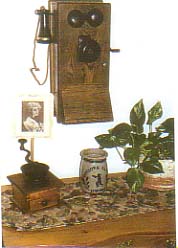
The classic wall model crank magneto telephone of the type used in HF exchange
until 1932 and
in exchanges of Lima, Caledonia and Scottsville until 1957. Photo courtesy
Roberta Luce.
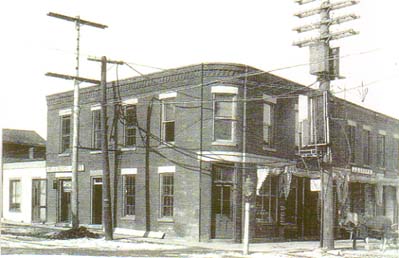
Ed Harnish Drug Store, c. 1900 housed telephone business in first floor rear
until 1907 and
the second floor until 1932. Phot ccourtesy HF-Mendon Historical Society.
All was quiet from 1911 or so until 1919, when Rochester Telephone Company
gathered in Federal Telephone, Home Telephone and Bell's New York Telephone.
Then that went out the window August 1st, 1921, when RTC spit it all out
again as Rochester Telephone Corporation. New York Telephone spun off to take
charge of long distance service—a service it performed for several decades.
Thank goodness consumers never had to see those crazy days again—oh, at
least until 1984, when the Federal Communication Commission forced Ma Bell's
divestiture and set off a riot of new phone companies.
But the writer is way ahead of his story, so let's return to the picture postcard
vicinity of Mendon Center. Rochester's Democrat & Chronicle (Nov. 6, 1900)
set the stage at a place along Clover Street, where motorists of today speed
along, unaware of the sacred ground made so by the brilliance of Alexander
Graham Bell: "...the Home Telephone Company of Rochester [think "Rochester
Telephone"] obtained of the village trustees a franchise permitting business
in Honeoye Falls. They intended to run their wires on the poles of the Rochester
Waterworks Company, but influence was brought to bear whereby the permission
to use their poles was revoked. They then concluded to continue their line
from Rochester to Pittsford and thence to Mendon Center, there, to connect
with the Mendon Center line, which was recently put up via Rochester Junction
to Honeoye Falls.
To block this route, it is reported that the Bell people purchased the right-of-way
over a farm owned by a Mr. Hayes and located at what is known as Surrine Hollow." (Surrine
Hollow embraces the intersection of Stoney Lonesome Road and Clover Street)
The Home company strung two copper lines out of Pittsford to within a mile
north of the Center, when they ran out of poles. It seems a carload of them,
destined for Rochester Junction, mysteriously vanished—but no one(?) supposed
this was a delaying tactic on Bell's part. Then there was the objection of
John Hayes, whose pocket full of Buffalo Bell money kept the Rochester interests
from hooking wire on Mendon Center Telephone poles all the way to Honeoye Falls.
Once the errant pole car was retrieved and Home lawyers had obtained a court
order allowing passage through Hayes' farm, the sparks started to fly. The
Democrat of 8/7/01 recounted events thus:
HOT FEELING OVER RIGHT-OF-WAY
While the work was going on yesterday afternoon, Mr. Lord, a farmer living
near Mendon Center, who was one of the promoters of the Mendon Center line,
became engaged in a dispute with Mr. Hayes over the matter, which finally led
to blows being exchanged. They were parted, however, before doing any great
damage to each other.
Less than two weeks later, peace was restored and Home found a home in Doc
Otis's Main Street pharmacy. Business people scrambled to add a second telephone
(since Bell and Home were slicing up the subscriber pie with no interconnection)
and townspeople in general debated the pros and cons of phone poles on the
landscape.
"Come to Lange's fish, oyster and clam market (today it's The Brewery)...
By telephoning George Pestel's market, your order will be delivered to
me and
promptly filled. My principle has always been to sell as cheap as can
be bought elsewhere. So give me a call." (HF Times)
"...a man can do most anything over the 'phone' but 'get full,' and
as farmers never drink they needn't come to the village during the
entire winter except to church on Sunday. Talk about hibernating, the farmer
can
give the
woodchuck all kinds of odds and beat him at his own game when he has
a 'phone in his domicile. The farmers will all have one in the near future." (Livonia Gazette)
"New York Telephone"
By 1905, with subscribers hooking up telephones at a steady rate, Honeoye Falls
also acquired 24-hour phone accessibility, when Bell manager and corner druggist,
Ed Hamish provided operator service all night long. With young Clella Stiles,
Cora Cooper and Gertrude Grace covering eight-hour shifts, and energetic Joe
Brooks keeping the equipment in fine fettle, who could want for more?
Ever willing to compete, the Home Telephone exchange, after surviving the squabble
up Surrine Hollow way, joined the Mendon Center company in the Cottage Hotel
(today's Critics front parking lot). Home's pay stations, for those doing without
direct lines, were found at Fred Wolfsberger's Farmers Supply Store on East
Street and Sarah Russell's Millinery Shop on Monroe.
The previous November, a special Bell line was put into the Cottage Hotel,
with Presidential election returns chalked on a canvas hung from the front
veranda. After Teddy Roosevelt swamped Alton Parker in that '04 race, the rig-up
was converted to a pay station, giving the architecturally eclectic hotel connections
with all regional exchanges.
In 1906, the Livingston County Telephone Company emerged from an association
of small independents, including the Mendon Center Telephone Company. This
new entity placed its business office in Lillibridge's Store on West Main,
precisely where G. R. Button's Bell phone exchange, and his life, came to an
end. The board at the Cottage, once Mendon Center's, was relocated to Lillibridge's,
leaving Home operating on its own. 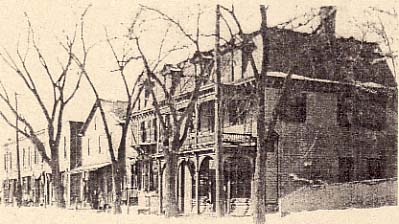
Cottage Hotel (nearest), Harnish Block (farthest) c. 1905
But modifications droned on, starting with a complete reorganization of the
Bell Telephone System. Harnish's Bell exchange, which had relocated its switchboard
to the second floor of the Allen Block (ex-Valentino's) in 1907, underwent
a name conversion two years later. The druggist himself wanted out of the
ever-competitive phone game, but, teased with money and offered a larger
territory, he elected to stay.
The 1909 edition of the Bell directory for Honeoye Falls told its own story
when compared to the previous year. Directory — Honeoye Falls Exchange.
The bell and circle logo stated: American Telephone & Telegraph and Associated
Companies - Bell System - and the obligatory Local and Long Distance Telephone
superimposed on the bell. The year before, January 1st, 1908, was simpler —
Honeoye Falls and Lima Directory - The Bell Telephone Co. - Local and Long
Distance
Telephone.
But all that was old news later in 1909, when two long, large signs were placed
atop the brick facade of Harnish's store. For a solid decade, 'NEW YORK TELEPHONE
COMPANY' glared down upon all who ventured through the Four Corners. Like "Big
Brother" we all fear today, those billboards espied all the Liberty Loan
parades, all the Saturday night band concerts and all the conveyances ranging
from horseflesh to horsepower. 'NEW YORK TELEPHONE COMPANY' watched the Iron
Man grow a little rust, the East Street bridge get replaced and the myriad
comings and goings of Village Hall entertainments. Hamilton's Flour Mill ground
on, the Central's 'Peanut Branch' trains steamed, hooted and clattered over
the creek bridge and skaters glided across a fairyland of snow and ice as
'NEW YORK TELEPHONE COMPANY' looked on.
Since no viable business ever stands pat, the decade of World War I saw further
corporate adjustments in the local phone climate. In the summer of 1911, Rochester
Telephone Company, Home Telephone and Livingston County Telephone all
fell under directorship of Federal Telephone and Telegraph of Buffalo. As
rumors persisted that the Bell Company eagerly sought control of
Rochester Telephone, one of the great quotes of the day fell ninety years short
of coming true: "IF ROCHESTER SELLS OUT ITS TELEPHONE COMPANY NOW, IT
SELLS OUT SOMETHING IT CAN NEVER BUY BACK, NO MATTER WHAT HAPPENS, OR HOW SPECIFICALLY
DESIREABLE IT BECOMES." (Democrat Chronicle, April 13,1911).
Honeoye Falls continued to adjust to those 'NEW YORK TELEPHONE' signs leering
from above, perhaps giving Bell and its parent AT&T more of a local identity.
Federal merged the two offices of Livingston and Home within the Lillibridge
block. Concurrently, "Home Telephone," in historic deference to the
local tag, continued to flow from the lips of the townspeople.
While the Rochester Telephone/Federal partnership added strength in the more
lucrative markets, Bell/New York
Telephone continued to help Manager Harnish's operation.
A new storefront in the adjacent McBride Block allowed for the commercial office
of New York Telephone to expand. The second floor was renovated to house
the construction department and the operators' exchange room
was dolled up with paint and wallpaper. Crowing of their cutting-edge
business, Bell ads gushed that since 1877, Bell had introduced 53 types of
receivers, 73 styles of transmitters... and, of the 12 million units of both,
none were in use just a dozen years earlier.
So the Honeoye Falls vicinity plodded through the teens divided by two non-connected
telephone systems. Imagine today, having two sets of old crank telephones mounted
on the kitchen wall, a pair of directories hung alongside for tracking down
the party you wish to contact and two sets of monthly bills — that was the
progressive household or business of the World War I era.
Looking from the perspective of 2003, with touch-tone and cellular buddies
at the ready, this old addage comes to mind: "What goes around, comes
around."
"Telephone Passing Luxury Stage: Held Necessity Now"
In 1915 and 1916, America was about to go to war overseas and, if being connected
with the outside world was not important in prior years, it sure was now.
The telephone was becoming a necessary companion in homes and business establishments
throughout the land.
As if to portend the world going to war, 1915 saw breakthroughs in transcontinental
and trans-Atlantic phone connections. In January, the invention team of Alexander
Graham Bell and his side-kick, Thomas Watson, conversed between New York and
San Francisco, making long distance service truly so. By November, such VIPs
as local boss E.K. Harnish, were invited to Rochester's Seneca Hotel, just
so they could have a direct word with San Francisco. Then, in October, fuzzy
voice communication skirted the ocean via "radio-telephone" between
Paris and Virginia. That was nearly a half-century after the vessel, Great
Eastern, unspooled a cable on the Atlantic floor, so Morse's telegraph code
could rattle instruments on the opposite shore.
With this hubbub of long-distance chitchat, Rochester's cool business minds
pondered the benefits of competing telephone companies. It was apparent that
telephone interests in Buffalo were no stronger than those of the Flour City.
So quotes such as this in 1916: "...the continued extension of duplicate
telephone lines in the growing cities of Rochester and Buffalo can mean nothing
other than wasted capital, which must, in the end, bring losses to the communities...",
led to these words in 1918: "...the properties of the two companies (Bell/New
York Telephone and Home/Rochester Telephone) will be consolidated by degrees
and many improvements are expected to result...."
Two Telephone Systems to Be Merged in Towns Near-by on September 1
It all took a little time, but 1919 for instance, saw the end of the Home Telephone
setup at Lillibridge's, linemen pulling down redundant lines and poles about
the township and Mr. Harnish tooling about town in a new company car. Those
garrish 'NEW YORK TELEPHONE COMPANY' signs over Main Street still mocked the
world of change, but only until the summer of 1921, when, at the stroke of
midnight, August 1st, 1921, the fully merged Rochester Telephone Corporation
became the only game in town. Gathered together under one title and one management
system were: six city exchanges, 35 centrals in outlying towns and over 60,000
telephones. Technically, New York Telephone still ran a third floor switchboard
on Fitzhugh Street, but it was strictly a long-distance operation not phased
out until 1969.
The ditty, "How Ya Coin' to Keep 'Em Down on the Farm, After They've Seen
Paree?", was not just a cute tune, it reflected the new age of wanderlust
spawned by World War I. America's young men and women traveled far to win the
glory—and they returned home restless beyond all measure. Even teams of phone
operators headed for the front. This social upheaval, nurtured by
the realization that the telephone culture was at hand, helped lead to an exodus
of millions seeking opportunity and adventure. America was on the move.
No longer were the only connections between loved ones the Rural Free Delivery
wagon, a bag of mail thrown from a speeding express or a 'flimsy' down at the
Western Union telegraph office. The telephone was a luxury still, but it was
very quickly becoming a necessity. The small town feel of the telephone business
was losing its quaintness as Honeoye Falls fell into the parent company's territorial
chess game. Through task consolidation, but three offices outside the city
(Mt. Morris, Warsaw, and Canandaigua) and an army of field crews kept Rochester
Telephone flying high. By 1927, "Watch Us Grow" was its unofficial
motto-statistically supported by a half-decade increase of 25,000 phones.
Corporate decisions out of Rochester did not please everyone—such as when
Ed Harnish turned down a Canandaigua transfer to remain a druggist in his corner
store. RTC closed the local commercial office May 1st, 1922, and, though valuable
for his long service, E.K. was also expendable. Months later, the world impact
of Alexander Graham Bell was realized. On August 2nd, 1922, as Bell himself
was lowered into a Nova Scotia grave, 13,000,000 telephones momentarily ceased.
However, technology was slow to change one institution now held dear in memory.
Those cute little stuccoed buildings once found in most towns large enough
for a manual exchange, provided a veritable relay to the caller's destination.
For those of us old enough to remember, the telephone operators housed within,
a force of women affectionately known as the "Hello Girls/' seemed like
messangers to 'Oz.'
Over the course of the century, one yardstick of change is that which has been
stolen from the very lap of the telephone operator. It is not difficult to
calibrate the effect on the American experience, when the old magneto crank
system and central exchange of the "manual" era, relented to the "automatic
age" of dial, touchtone and the bedlam of cell.
"The Girl-less, Cuss-less Telephone"
It must be admitted that a 19th Century inventor named Almon Strowger was,
for debatable reasons, none too fond of Hello Girls. An undertaker by trade,
Strowger thought business was diverted to a rival undertaker in cahoots with
a telephone operator. Vengeful, impatient character that he was (and a local
Penfield boy tool), Strowger cobbled together the first automomatic dial system
from straight pins, a collar box and a pencil. Then he had the temerity to
advertised it as, "...the girl-less, cuss-less, out-of-order less, wait-less
telephone."
It achieved a modicum of success in pockets around the U.S.A. (LaPorte, Indiana
and nearby Albion, NY among them) but it certainly did not set the world on
fire. He patented the concept way back in 1889, and operators, at least those
in Honeoye Falls, were still aggravating dastardly guys like Strowger three
generations later!
As long as there were manual systems—pick up the phone, crank, waiting, "Number
please," give the number, wait for the connection, answer, "Go
ahead please," —there were "Party Lines." When companies
were plying the public to subscribe to their telephone service, the cheapest
tease of all was the
party line, where several customers shared a single line to the central office.
This system was thought to attract folk into making the telephone a habit.
Then, after so many teenagers hogged the line or eavesdroppers cultivated
the grapevines of gossip, a switch to a private line justified the added
expense. But many Americans liked the homey quirkiness of the party line
and kept it a national institution until the manual setup was completely
phased out. As late as the 1950's, 75% of Americans relied on their party
line.
But first to go in Honeoye Falls was the old crank magneto system of turn-of-the-century
vintage. A cute new Swiss chalet-styled building, two blocks up Monroe Street
from Harnish's Drug Store, accomplished that in 1932. On July 18th, over 600
customers (262 of them rural) were hooked into the new Stromberg-Carlson common
battery system, with four Hello Girls working the switchboard at all times.
The once lively second floor of Harnish's fell to storage and neglect; 'Bub'
Frank took over the building before the 1930's played out. Precisely on the
33rd anniversary of its opening, July 18th, 1965, the manual office of Honeoye
Falls took its last call. The operators disbursed and within a few days, the
distinctive little phone building no longer existed.
But that is the end of
the era—a final act that took Rochester Telephone thirty years to accomplish.
This Great Contrivance, a superb book celebrating the first century
of telephones in the Rochester area, did a masterful job of explaining
the erratic
phase-out
of the manual age. Edited by F. L. Howe, the tome stated:
In the 1930's,
when the company might well have begun to convert under normal
circumstances, it was unable to raise the necessary capital. Its Depression
construction budgets were bone thin, its work force reduced. World War
II then intervened and telephone equipment of any kind was virtually impossible
to acquire. After the war, when the company was finally in a position
to
plan a dial network, all switching equipment was
in short supply.
While Honeoye Falls' operators trouped in and out of the Monroe Street
office, they learned of Leicester going to dial in 1936 and a cluster of
Steuben neighbors
(Wayland, Cohocton, Atlanta) and nearby Springwater in Livingston County following
suit in 1938. But conversions slowed, when only Nunda and Avon followed over
the nine years sandwiching World War II. The spirit of feisty Almon Strowger,
dead since '02, must have taken delight as the region of his nativity eliminated
the Hello Girl system. Others were not so gay, as exemplified by one eulogy
out of Weedsport, NY: "The event marked the passing of one of the nation's
most beloved institutions—the Telephone Operator."
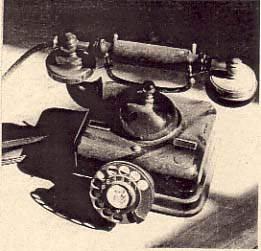
A reenergized Rochester Tel geared up for the big push in 1948 and 1949 by
converting Rochester's downtown exchanges, followed by eighteen more city and
town units in the 1950's. While there was a short stumble when balky equipment
forced a move to Western Electric hardware, observers at Honeoye Falls witnessed "girl-less,
cuss-less" all around them - marching toward their village. But the antsiness
of a new breed of citizen indicated the phone company could do only so much.
Noted The Great Contrivance: "Hundreds of customers living in
the booming Rochester suburbs were still reluctantly sharing four and eight
party lines,
unable to get the individual line service they were willing to pay for."
Of 42 exchanges, the old crank towns of Lima, Caledonia and Scottsville pushed
RTC transformations beyond the mid-point, when they vaulted straight to dial
in 1957. A simple grey building was erected for Lima's new gear and manual
service was connected to the slightly enlarged office in Honeoye Falls. While
the two antique switchboards were preserved for posterity (displayed at the
Lima Historical Society), the six regular operators, veterans all, gained solace
in the memories of their noble careers. (Just weeks before the transition,
the late Mabel Jenks wrote a wonderful summation of Lina's manual telephone
history.)
Inexorably, the conversion program marched on: Fairport, East Rochester, Pittsford...
Henrietta, Rush, Livonia, Hemlock... then Rochester finally went 100% dial,
followed by Webster, Brockport, Mt. Morris and LeRoy. Synonymous with the Alamo,
New Year's Day of 1965, found pockets of pioneering Hello Girls standing strong
in five towns (Geneseo, Warsaw, Dansville, Churchville and HF) —and all but
one survived the year.
No, it was not Honeoye Falls carrying the banner to a poetic end—the Davy
Crockett toga went to Churchville, whose operators met their career fate at
the cruel hour of 3:01 AM on May 15th, 1966.
"The Best is Yet to Come"
No one in Honeoye Falls was surprised when Rochester Telephone sent technicians
door-to-door with new fangled dial phones in hand. This phase came after...
three decades of town-to-town change relegated operators to the past; news
as early as 1960 stated Honeoye Falls would soon go dial; a trailer by the
old Hamilton Mill allowed locals to try out rotary phones; form letters to
subscribers explained the whens and wherefors of the new era; and, most importantly,
those letters assigned customers the new seven-digit numbers we all know and
love.
The Thoreau philosophy of "Simplify" was all down the drain when
that durn letter said: "'Your Present Number is: 88R — Your Future
Number will be: 624-1626." How could this teen know how complicated our
lives of convenience would become? Wasn't Henry David suggesting, a hundred
years previous, a simple life and a convenient life make for strange bedfellows?
Gone were the days of soliciting the operator to ring up my friends at 255M
or 222W, or Aunt Chottie and Uncle Herb at 268M. My dear departed mother
asked for 53 to give Harland Moffitt her grocery list or 103 to ask Seymour
Davis
at the Lehigh depot to send me home for lunch. Sometimes, she needed the
school's 274 to converse with Mrs. Bixby on an issue of (yikes!) the writer's
2nd grade behavior. If the end of Honeoye Falls' Hello Girl days was not
clear in the minds of some folk after July 18th, 1965, then a big, old bulldozer
emphasized the point. Just a few days after the manual system wires were
cut, telephone central was pushed to the ground and swept away.
Patiently standing behind the site for nearly a year, waiting its turn to be
the belle-of-the-ball, was "dial Central Office." A boxy, green
brick testament to the crassness of '60's architecture, this monument to
Rochester Telephone's automation exemplified the decade. Like the "mom & pop" markets
of Moffitt, Reeves and the Ruby boys, the soda jerk in Emblidge's, Buck Shirley,
the town cop, and few other departed institutions, the little Hello Girls chalet
had no use in the modern age.
Many landmarks on the highway through time have mollified supplanting touchy-feely
telephones for technological temptresses. For instance, just months after the
conversion, a rather thorough blackout of the Northeastern U.S. severely tested
Rochester Tel. Its heroic performance in keeping communications going helped
citizens adjust to the wonders of the new world of dial. By the 1970's, the
company had 500,000 phones in its stable and a new road image. Like the yellow
school
bus, RTC's "Telephone Green" vehicles were familiar sights
on the landscape. But the times were a'changin', the company was robust, and
the fleet was decked out in new finery. Perhaps the color scheme reflected
the management's opinion of its collective self... everything they touched
turned to [two-tone] gold.
Each vistage of the telephone past was matched with news of what we now take
for granted. Not long after the little Schoharie County burg of Summit, New
York, bid adieu to the last manual operator system in the state (January, 1973),
Rochester Tel was christening the birth of "911" down in Livingston
County (June 1975). In 1979, the centennial Rochester Telephone Directory,
with thousands of listings, contained the names of a few companies among the
inaugural seventy listed in the 1879 muster. (Among them: Bausch & Lomb;
Democrat & Chronicle; Genesee Brewing and Sibley, Lindsey & Curr.)
The same year, Ruth Bowles in Grand River, Iowa, converted her little phone
operation to dial—leaving Elden and Barbara Hathaway of Bryant Pond, Maine,
to carry on as the last crank magneto outfit in America. In 1983, after keeping
their cozy living room telephone exchange on the manual system far beyond its
prime, the Hathaway family's "Bryant Pond Telephone Company" gave
up the ghost.
No one wanted to let it go. The media rushed to Bryant Pond. "Good Morning
America," "The Today Show," "Real People" and Johnny
Carson's "Tonight Show" were among those who created a national hubbub
of nostalgia. Isn't it a little odd the human race is hell-bent to constantly
redecorate its life, then gets all kinds of whimsical when those rejected institutions
go the way of the Dodo Bird?
Epilogue
Well, Shirley [Shirley Thomas Arena, publisher of The Mendon-Honeoye Falls-Lima
Sentinel] wants me to wrap this up, so the writer will attempt to squash
twenty years of
telephone
doings
into
a
few
more paragraphs.
By outward appearances, little has changed in Honeoye Falls. The green monster
still sits there lording over Dick Dye's funeral shop and several of the old
vestiges of the manual era remain. A stroll around town, with a focus strictly
on telephone history, would make a pleasant little tour for those with a curious
bent. But it is the outlying, big business aspects of phone life where the
real mud-rasslin', shoot-em-up activities have transpired.
In 1984, the federally imposed divestiture of American Telephone & Telegraph,
Bell's parent company, knocked out the monopoly that had been reassembled since
the Bell patents expired ninety years earlier. With play money of $115 billion,
182 million phones and a billion miles of wire (a mile for every employee) "Ma
Bell" was spun off into numerous "Baby Bells" - and the famous
Bell logo was history.
The telecommunications industry was going gangbusters as Rochester Telephone
moved through the 1990's. Under the direction of its CEO, the company changed
its name and business theory to reflect the global business climate. "Frontier
Corporation" was its new herald, but it liked the folksiness of its roots
and chose the more cuddly lower case tag, "frontier," for its letterhead,
its trucks and even its spiffy new Red Wings ballfield.
Tragically, the popular CEO was stricken with cancer and died in 1997. The
new fellow was a hard driving, domineering Texas sort who tempered his image
with easily digestible quips like, "You gotta go where the geese are flyin'." This
insinuated that, with suitors Qwest and Global Crossing baying at Frontier's
corporate door, more big changes were in the offing.
The menage à trois of sorts swayed the Rochester company into
believing it was that key international link that would bring untold riches
to Frontier
shareholders. On September 24, 1999, a century of Rochester Telephone/Frontier
autonomy ended, when one Gary Winnick of Global Crossing proposed marriage
with a $9 billion ring—and Qwest became the jilted suitor. Hardly before
the honeymooning ended, the marriage failed. Winnick has since resigned in
disgrace, returned to his palatial digs in Boca or somewhere, and left stockholders,
pensioners and employees to an uncertain outcome.
Frontier goes on, its logo subscript of "Global Crossing Company" replaced
with "A Citizens Communications Company"—the latest provider
of a hopeful future for many caught in the mire. "Number please," were
the two bedrock words we heard for three generations of telephone use. "Surfing
the Internet" - "Cellular Wireless" - "Fiber-optic" - "Broadband" - "Next
Generation" all connote a cosmic world that Henry David Thoreau, while
lazing out on Walden Pond, could not have envisioned a century and a half ago.
At least there is a measure of solace for the future streetscape in Honeoye
Falls. I am told that, one fine day, the green monstrosity on Monroe Street
will get its just deserts from the global communication sciences. Its 5,000
square foot capabilities of present day will eventually be housed in a new
fiber-optic facility—one the size of a briefcase!
This article was first published in The Mendon-Honeoye Falls-Lima
Sentinel
©
2003, Paul S. Worboys
|

